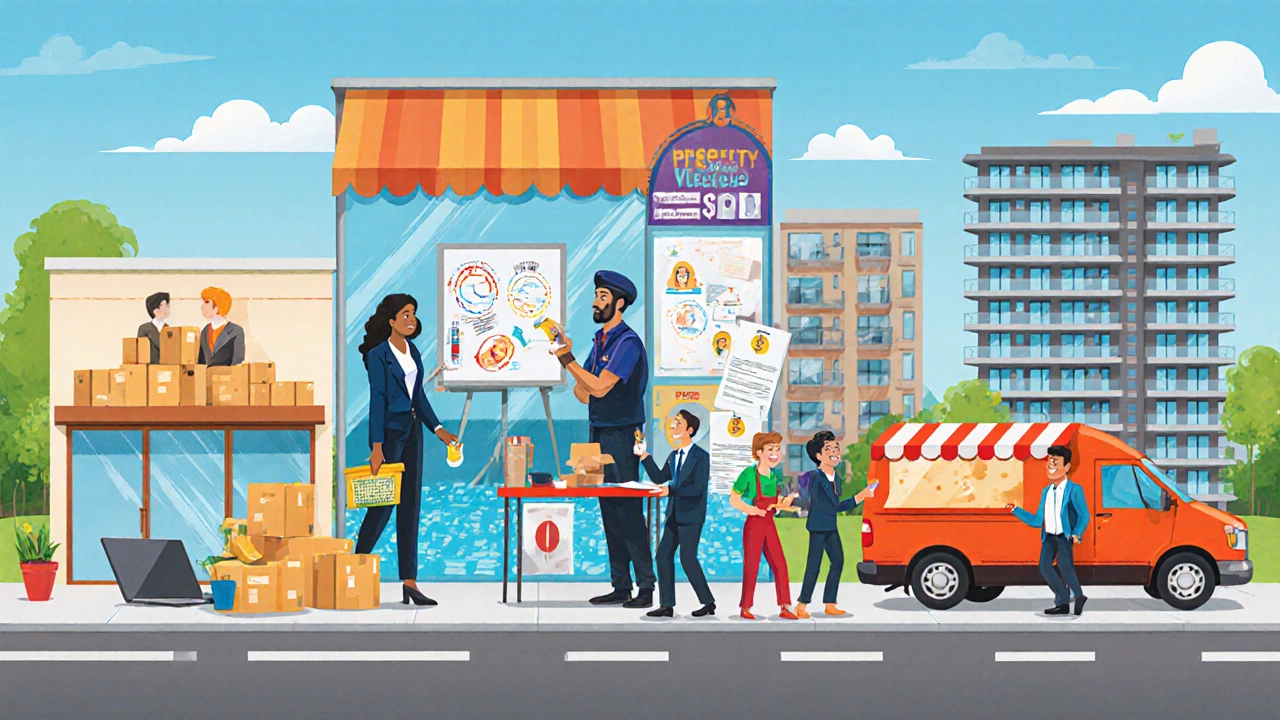Small Business Profitability Calculator
How Profitable Is Your Business Idea?
Estimate annual revenue potential based on the most profitable small business models from Australia's top earners.
Why This Matters
Businesses that consistently generate high revenue typically maintain:
- Scalable revenue streams with low overhead costs
- Profit margins above 15%
- Strong demand for services/products
Ever wonder which small businesses actually rake in big numbers? It’s easy to get lost in hype, but the data tells a clearer story. Below you’ll find the business types that consistently generate the highest revenue, why they do well, and what you need to launch one without breaking the bank.
What Makes a Small Business "Profitable"?
Before we rank the sectors, let’s define the yardstick. Profitable Small Businesses are typically defined as enterprises with fewer than 50 employees that achieve an average annual revenue of $500,000 or more while maintaining a net profit margin above 15%.
Three factors drive those numbers:
- Scalable revenue streams - services that can serve many clients without a proportional rise in costs.
- Low fixed overhead - minimal rent, utilities, or inventory needs.
- High demand elasticity - customers keep buying even when prices shift slightly.
Keep these criteria in mind as you scan the list.
Top Revenue‑Generating Small Business Types
The table below compiles data from the Australian Bureau of Statistics, industry reports, and recent case studies. Figures are averages for Australian businesses in 2024‑2025.
| Business Type | Average Annual Revenue | Typical Startup Cost | Net Profit Margin | Growth Outlook (2025‑2030) |
|---|---|---|---|---|
| E‑commerce store | $850,000 | $15,000 | 20% | High - 12% CAGR |
| Digital marketing agency | $720,000 | $8,000 | 22% | Very High - 15% CAGR |
| Cleaning service | $560,000 | $5,000 | 18% | Moderate - 8% CAGR |
| Food truck | $620,000 | $45,000 | 19% | Steady - 6% CAGR |
| Property management | $780,000 | $12,000 | 21% | High - 10% CAGR |
Why These Five Lead the Pack
Each of the top five shares a common DNA: low barriers to entry, repeatable services, and a customer base that’s growing online.
E‑commerce stores profit from global marketplaces and can scale with dropshipping or private‑label products. Digital marketing agencies sell expertise that businesses desperately need to stand out in a crowded digital world. Cleaning services benefit from recurring contracts-think office cleaning or residential maintenance-so cash flow stays steady. Food trucks tap into local events and festivals, offering a low‑rent alternative to brick‑and‑mortar restaurants. Finally, Property management leverages existing real‑estate assets and charges fees that often exceed the cost of maintenance.
All five require a strong online presence, but the initial cash outlay stays modest compared to traditional retail.

Other Small Business Ideas That Can Hit Six Figures
If you’re not sold on the top five, here are additional sectors that regularly break the $500k revenue barrier:
- Home‑based business - consulting, freelance writing, or virtual assistance. Low overhead, flexible hours.
- Franchise - proven brand, often in fitness or education. Higher startup cost but strong support.
- Health and wellness service - personal training, yoga studios, or nutrition coaching. People are spending more on self‑care.
- Pet care business - grooming, boarding, or mobile vet services. The pet market grows ~7% annually.
- Specialty food production - artisanal jams, gluten‑free snacks, or craft chocolate. Niche markets pay premium prices.
Each of these can be launched with under $30,000 and still reach the six‑figure milestone within two years if you nail the niche and market effectively.
Step‑by‑Step Checklist to Launch a High‑Earning Small Business
- Validate demand. Use Google Trends, local surveys, or pre‑sell on platforms like Kickstarter.
- Calculate realistic numbers. Estimate revenue based on comparable businesses; factor in a 15‑25% profit margin.
- Secure funding. Small business loans, government grants, or bootstrapping-pick the cheapest option.
- Choose a legal structure. Register as a sole trader, partnership, or Pty Ltd in Australia.
- Set up online assets. Build a simple website, claim your Google My Business listing, and open social media profiles.
- Launch a minimum viable product (MVP). Offer a limited service or product batch to test the market.
- Iterate and scale. Use customer feedback, reinvest profits, and add complementary services.
Following this roadmap drastically reduces the risk of sinking money into a venture that never takes off.
Common Pitfalls and How to Avoid Them
Even the most promising ideas can falter. Here are the three biggest traps and quick fixes:
- Underpricing. Many starters think low rates attract customers. In reality, it weeds out serious clients and squeezes margins. Benchmark against industry standards and price for value.
- Ignoring cash flow. Revenue looks great on paper, but late payments can choke growth. Implement a 30‑day invoicing policy and keep a buffer of at least three months’ operating costs.
- Skipping the digital strategy. A business without a website or social presence loses 60% of potential leads. Allocate a modest budget to SEO and paid ads from day one.
Resources for Aspiring High‑Profit Entrepreneurs
Australia offers a suite of programs that can cut your startup costs:
- Business.gov.au Grants Finder. Filters for industry, location, and funding type.
- NSW Small Business Grants. Up to $10,000 for tech‑enabled projects.
- Australian Taxation Office (ATO) - GST registration. Helps you claim input tax credits on equipment.
- Local chambers of commerce. Provide networking events and mentorship.
Take advantage of these resources before you spend your own cash.
Bottom Line: Pick a Model That Matches Your Skills and Market
There’s no single answer to “what kind of small businesses make the most money?” The data shows that most profitable small businesses are those that combine low overhead, repeatable revenue, and growing consumer demand. Whether you gravitate toward an e‑commerce store, a digital marketing agency, or a niche home‑based service, the formula stays the same: validate, keep costs lean, and market aggressively.
Frequently Asked Questions
Which small business has the highest profit margin?
Digital marketing agencies often enjoy margins above 22% because the main input is human expertise, not inventory.
Do I need a physical location to run a profitable small business?
No. Home‑based businesses and e‑commerce stores can operate entirely online, keeping rent expenses near zero.
How much capital should I set aside for a food truck?
A typical start‑up cost ranges from $45,000 to $70,000, covering the vehicle, kitchen equipment, permits, and initial inventory.
Is franchising a safe way to hit six figures quickly?
Franchises provide brand recognition and support, but the upfront fee can be $50,000‑$150,000. Success depends on location, market fit, and your ability to follow the proven system.
What’s the fastest way to test my business idea?
Launch a minimum viable product (MVP) - a simple version of your service or a small batch of product - and gather real‑world feedback before scaling.

